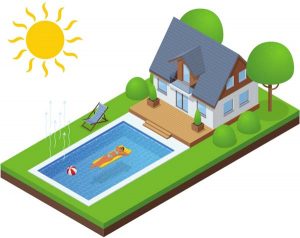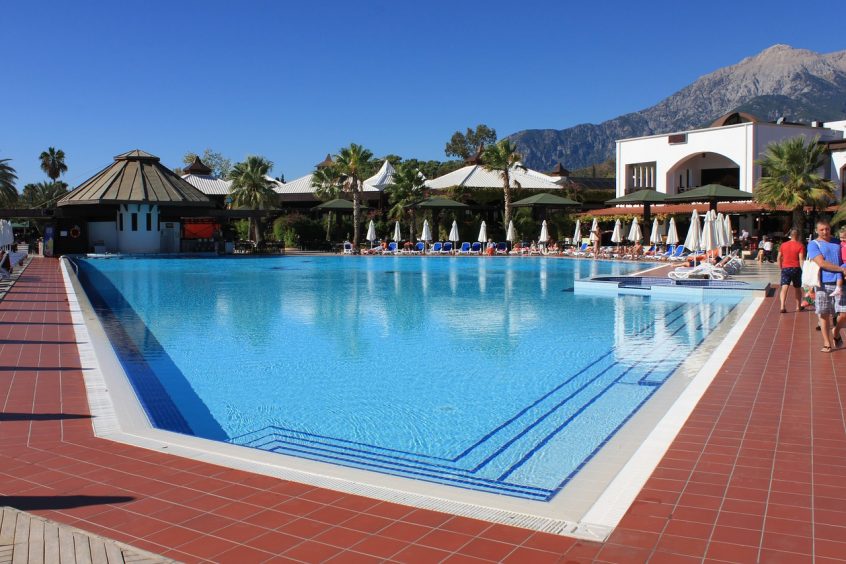Water is a precious resource that everyone must work to preserve. Reducing evaporation helps conserve water in backyard pool environments and reduces the amount of fill water needed during the season. Industry professionals can save their customers water, money, and energy by recommending the use of a liquid solar cover product as part of their pool maintenance program.
Also known as evaporation suppressants, liquid solar covers do not work to heat the pool water, but instead reduce heat loss due to water vaporization. When water evaporates, the process requires energy in the form of heat (i.e. the heat of vaporization). Energy is needed as water molecules begin to dance around and disassociate into a vapor gas. Evaporation suppression reduces this process by controlling the rate at which vapor escapes from the water surface (considerably slowing down the dancing of the molecules).
Using a liquid solar cover saves heat and water reduction from evaporation. It also helps to retain heat radiation from the sun and, as a result, keeps the pool water warmer, longer.
Blowing off some steam
If a service professional has ever observed steam coming off a pool, they have witnessed the evaporation process. It occurs when a liquid becomes a gas or vapor. Water closest to the surface is constantly changing into water vapor. The main factors contributing to this occurrence include:
- The larger the pool’s surface area, the more water will evaporate.
- If the water temperature is higher than the surrounding air.
- Windy conditions can increase water evaporation.
- The drier the air is (relative humidity) the more evaporation occurs.
- The strength of the radiation from the sun plays a vital role in evaporation.
In the Northern Hemisphere, evaporation rates are highest during the drier months of June, July, and August. This is because water needs heat to reach the point of evaporation. Case in point, it is possible for a 56,781-L (15,000-gal) pool to lose as much as 5678 L (1500 gal) a month during this period.
According to the National Swimming Pool Foundation’s (NSPF’s) Pool and Spa Operator Handbook, 50 percent of relative heat loss is due to evaporation. When water evaporates from pools, the water level needs to be topped up constantly. Further, when evaporation occurs, only pure water leaves. As a result, additional solids are left behind and calcium hardness increases along with total dissolved solids (TDS).
In some cases, the contents of the source water (e.g. metals or phosphates) can result in added expenses to the pool owner due to the necessary adjustments required. The balancing process has to be started again. This leads to additional labor and the added expense of using extra chemicals.
Reducing evaporation using a liquid solar cover can be a cost-effective way to reduce the need to replenish pool water and make chemistry adjustments.
A look at traditional methods

The biggest difference between a physical solar cover and a liquid product is the former does nothing if it is sitting bunched up in the homeowner’s backyard.
The use of a properly maintained pool cover can significantly reduce evaporation and water wastage by as much as 95 percent. Solar bubble covers are especially great at the beginning of the season to help the water heat up more quickly. There are, however, some downfalls to using a solar blanket, which some pool owners may not realize at first until they have to wrestle with it to put it back on. They can be bulky, tough to move, and in some cases can introduce additional dirt and debris to the pool after being dragged through the yard.
Further, leaving a solar blanket on the pool too long—especially during a string of hot days—can overheat the pool water. As a result, chlorine is consumed more rapidly, which can lead to the water turning green. Automatic pool covers are also available; however, due to their cost, they may not be an option for every pool owner. For these reasons, some pool owners may want to consider the use of a liquid solar product.
These products also help to retain heat in the water for those pools equipped with a heater, which can extend the swim season. It takes one British thermal unit (Btu) to raise 0.45 kg (1 lb) of water by one degree. However, each pound of 26-C (80-F) water that evaporates takes 1048 Btu’s of heat out of the pool.
Types of liquid covers
There are different types of liquid solar evaporation suppressants used in the pool industry, including cetyl alcohol, stearyl alcohol, and ethyl alcohol (ethanol). The technology of evaporation suppression uses monomolecular films. The films are a single molecule in thickness and create additional surface tension. All of these are fatty alcohols so they readily float on the water surface.
Dispersants are also used in the formulas to spread the material across the water surface, which is a technology from the drinking water reservoir industry. Numerous studies on evaporation suppression go back to the ’50s and ’60s, and many ingredients have been tested, but the studies concluded the use of cetyl or stearyl alcohols were found to be effective. In some cases, combining the two alcohols proved to be the most effective at reducing evaporation.
All three types of liquid solar products are tested and proven non-toxic. In fact, cetyl and stearyl alcohol can be found in numerous cosmetics and detergents, and are used for food preservation, as well. The levels of ethanol-based liquids have been tested and shown to be relatively benign in pool use; however, it can be flammable.
How liquid covers work
Liquid evaporation suppressants create an invisible barrier on the surface of the water to help trap heat and reduce evaporation. The product is added to the skimmer, with the circulation system running, to disperse the monomolecular layer on the surface. This can be likened to putting a lid on a pot of boiling water.
Some pool professionals have expressed concern about the formation of chloramines and the inability of oxidation gases escaping the pool due to the surface tension caused by these products. That said, despite its ability to move with the motion of the water surface, these films are disrupted when the surface tension is broken (e.g. during swimming, high winds, or rainfall, etc.). When this happens, there are plenty of opportunities for gases to escape to the atmosphere. Further, these films have some natural permeability, as well.
The purpose of liquid solar technology is to reduce heat loss and evaporation, and it even works when bathers are in the pool. While the surface tension can be broken when swimmers are present, the tight molecular arrangement of the film allows it to reform quickly. The typical evaporation reduction rate of liquid covers is between 15 to 40 per cent. Considering the 56,781-L (15,000-gal) pool that loses 5678 L (1500 gal) a month in the summer, a liquid solar cover can save between 852 and 2271 L (225 and 600 gal) of water per month. Over the course of the summer, it can save between 2555 and 6814 L (675 and 1800 gal) of water.
The biggest difference between a physical solar cover and a liquid product is the former does nothing if it is sitting bunched up in the homeowner’s backyard. If someone forgets to put the solar blanket on the pool when the temperature drops on a cool night, considerable water and heat loss will occur. When liquid solar products are used in conjunction with a physical pool cover, it increases the coverage and provides added protection.
Backed by pool professionals

The strength of the radiation from the sun plays a vital role in evaporation.
Pool professionals are now realizing the importance of offering these products to their clients. For example, Dick Abare from Algae Busters Pool Service in Tampa, Fla., who was introduced to the product by a colleague, started offering a liquid solar blanket option to his customers after trying it first on his own pool.
“I was sitting poolside with my wife one evening watching a cloud of steam rise above our pool,” says Abare. “I poured in a sample of the liquid solar blanket product I was given and I watched as the pool stopped steaming and the water returned to a glass-like appearance.”
Since then, he has been offering liquid solar covers whenever he sells or repairs pool heaters.
“When customers are investing in a pool heater, I want to be sure they are satisfied with their purchase,” says Abare. “We include the liquid solar cover product with our start-up package and explain to the client they should include it in their weekly pool maintenance routine to prevent evaporation and heat loss.”
Kathi Belcourt of Aqua-Tech Pools, Spas & Bath in Winnipeg, Man., has also had success selling this product to her customers.
“At first we thought it would be a tough sell, because we are essentially selling them something they cannot see,” says Belcourt. “However, as opposed to a physical solar cover, it is the fact the customer does not see it is what makes this product appealing.”
According to Belcourt, the main reason they have had success selling these products is that it fixes the ‘problem’ of the traditional solar blanket, which can detract from the beauty of the pool. Many pools are the centrepiece of the landscape; therefore, covering it prevents the client from enjoying this visual focal point. In fact, some clients have told her the liquid solar cover has enabled them to enjoy their pool more in this perspective.
Belcourt is also convinced the traditional solar blanket, in some cases, can decrease the client’s use of their pool because they can be cumbersome to handle.
“When a pool owner gets home from work and looks outside at a 5.5- x 11-m (18- x 36-ft) solar blanket, the thought of grappling to try to remove it to go swimming can seem daunting—especially if someone is attempting to do it on their own,” she says.
In this regard, Aqua-Tech Pools, Spas & Bath has also received several positive reviews from customers. One client, for example, has a remote cottage with a vanishing-edge pool, which requires water to be trucked in to fill it. This client preferred not to cover the pool, as it is the primary feature on the property.
“It depressed the client to put a solar blanket on the pool; however, if she did not use it, she would lose about 25 mm (1 in.) of water per day due to evaporation and she could not afford to truck in that much water,” says Belcourt. “After selling the client the liquid solar cover product, she added it once a week and she was able to leave her pool uncovered all summer without needing to add any water over an eight-week period.”
For these reasons and more, a liquid solar cover can be a great addition to a retailer’s product lineup that can enable customers to save energy, chemicals, and money when operating their pools this summer.
This article was written by Terry Arko and originally appeared on Pool & Spa Marketing [link].
